Non-return valve for sewerage: installation guide for shut-off device
Unscheduled repairs are unlikely to please anyone. Especially when an apartment or country house is flooded with waste water from a sewer pipe.A sewer check valve can prevent a local disaster. All you need to do is choose the right model and install it.
We will tell you how the device works and why it will become the best protector against backflow of sewage for the next 5 years or more. We describe in detail the types of valves, their design features and operating rules. Taking into account our recommendations, you can choose the ideal device that solves your problems.
The content of the article:
Structure and purpose of shut-off valves
To protect your home from a sewer flood and not to cover the openings in the sink, bathtub and toilet all night with towels, bathrobes, bedspreads and anything else that comes to hand, special locking devices are installed. Sometimes even one plastic bag accidentally flushed down the toilet can cause catastrophic consequences.
What is a check valve?
To protect against the flow of wastewater in the opposite direction, special devices are used that operate at the right moment and block the path of waste water. This is a shut-off valve used for sewerage in private houses, apartments, office premises, production facilities. Shut-off devices are also installed in heating and water supply systems.
Check valves are able to close the hole in the sewer pipe at the right time.And all the drains that started moving in the opposite direction will be forced to look for another path.
This situation can occur in a multi-storey apartment building, where there is usually a common riser for residents whose apartments are located under each other. Then the sewer eruption can be seen even on the 2nd floor, if the residents of the 1st floor took care to install a sewer shut-off valve.
If the valve is also located on the 2nd floor, then the sewer column is unlikely to reach the 3rd floor - under the pressure exerted by it, the blockage will be pressed through and everything will float away where it should - into the common house sewer pipe.
Design and operating features
Sewer shut-off valves can come in a variety of shapes and sizes. They are made from different materials and have different working parts. But they all act the same way - they block the path of drains that have sharply changed the direction of their movement.

In general, the valve consists of the following parts:
- inlet and outlet pipes;
- lever for forced drainage;
- membrane/working body to cover the entire cross-section of the pipeline;
- cover for inspection and cleaning.
The working mechanism depends on the model - it can be a rubber ball, a valve or other device that completely blocks the pipe.
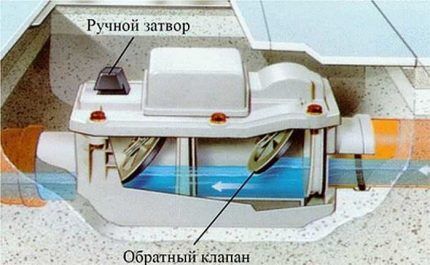
Is it necessary in principle?
Locking devices are not required to be installed in all situations. In some cases, these devices can be dispensed with.
For example, a family living in an apartment on the 5th floor may not have to worry about the bathroom being flooded by sewage through a clogged riser.
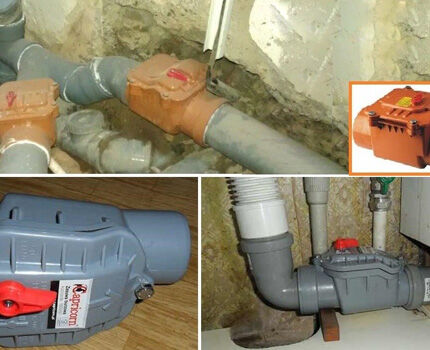
A check valve is needed if:
- the apartment is located on the 1st or 2nd floor of a high-rise building;
- in a private one-story house/dacha;
- in a 2 or 3 storey cottage;
- in office premises on the 1st-2nd floors, especially if the building has old pipes.
It is for these categories of premises that it will be cheaper to install a locking device than to deal with the consequences later.

Types of check valves
All sewer shut-off devices can be divided according to the installation location:
- for the street;
- for the premises.
If the device is to be installed in a street sewer pipe, then you should choose a frost-resistant model with high throughput.
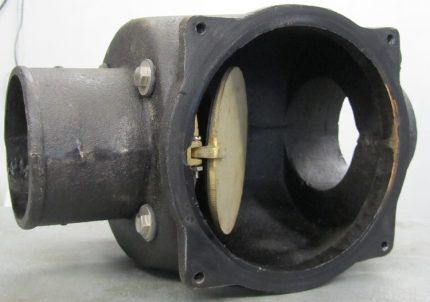
Depending on the installation method, there are:
- flanged;
- wafer;
- coupling
The second option requires the use of welding and is used in metal pipelines. But this is a quick and easy method that does not require much time to install.
The flange method is used to install a check valve on large diameter pipes. Most often on the street. The coupling method is more convenient for installing devices of small diameter. This option is mainly used indoors. The main thing is that when installing, choose a place where you can safely remove the cover and clean the valve if it is clogged.
Also, according to the type of locking device, there are rotary, lift and ball valves. This is a difference in the way the locking mechanism is attached to the device itself. In a rotary valve, a damper is used; in a ball valve, the working body is a ball that closes the cross-section of the pipeline.
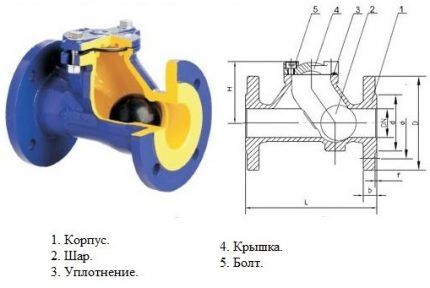
In the lifting model of the shut-off valve, there is a special lock - a spool that moves under the influence of a spring or under its own weight.

Nuances of choosing a check valve
Before purchasing a locking device for personal use, you should carefully analyze the features of your sewerage systems. Based on its specifics, you have to choose.
When choosing the best option, you should pay attention to the following characteristics:
- diameter of sockets;
- material;
- fixture size;
- installation complexity;
- quality and guarantee;
- price.
Moreover, price is clearly in last place - the reliability and functionality of the valve do not depend on it. Here you should focus on your financial capabilities. For example, there is no point in buying a sophisticated model of a locking device with an electric motor for more than 120 thousand for a modest dacha with cheap plastic sewer pipes.

The most important parameter is the diameter of the sockets. This is the key characteristic and must match the diameter sewer pipe, in which the check valve is to be installed.
Taking a smaller or larger cross-section of the device and buying special adapters would be the wrong decision. This will disrupt the smooth functioning of the system and may disrupt the throughput of installed pipes.
The material from which check valves are made is the same as the material of sewer pipes:
- plastic;
- steel, including stainless steel;
- cast iron;
- bronze;
- other materials, less common.
From the available options, it is best to choose the same one as the installed sewer pipes in a house, cottage, or apartment. It is not advisable to embed a plastic valve into a cast iron pipeline and vice versa. Moreover, plastic models are the most affordable.
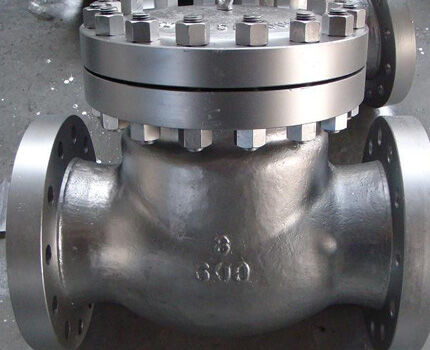
As for the size, the locking device should be selected based on the availability of space for its installation. Do not forget that there are valves for vertical and horizontal installation.
Most often the second option is chosen. But if there is not enough free space in the bathroom, kitchen, behind the toilet or in the utility room, take the vertical option.

The cost of installation work depends on the ease of installation if you plan to invite a plumber. If this is a simple plastic model, then a home craftsman with a minimum set of tools can install it.
Also, before purchasing, it would be a good idea to look at the model you like and check it so that nothing dangles or creaks under your fingers. You need to pay attention that there is an arrow on top, marked by the manufacturer.
Each high-quality product must indicate the direction of movement of sewage, which eliminates errors during installation.
You need to ask the seller for a manufacturer's warranty for this product. A high-quality product produced at the factory always has warranty documents and installation recommendations.
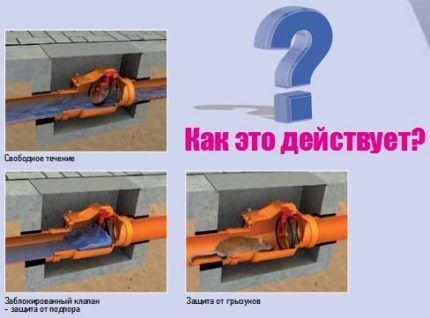
Features of installing a locking device
The best option for installing a shut-off valve is renovating an apartment or building a house.It is at this stage that it is easiest to design the location of its placement and calculate the required length of pipes. In this case, the locking device will be installed during assembly of the entire sewer system.
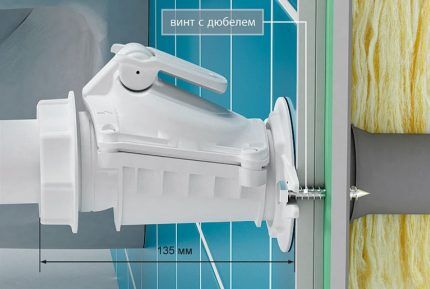
Most often it happens that no one plans to do repairs, but the valve needs to be installed. Then you should choose this device based on the realities of your sewer system. If the shut-off valve has already been selected and purchased, you can deal with the issue of its installation.
There are 2 options:
- do everything yourself;
- invite a plumber.
Depending on the material of the pipes in the apartment/house, the installation methods and the list of work required will differ. The price of the issue will also differ - for cast iron fittings, removing a part to install a shut-off valve in this place is much more expensive than a similar amount of work with plastic materials.
When you choose the option of inviting a master, you will only need funds to pay for his services. It is also advisable to monitor the work and check the quality of the installation so that problems do not arise later. It is best to contact a plumber who services your home/is assigned to a specific area.
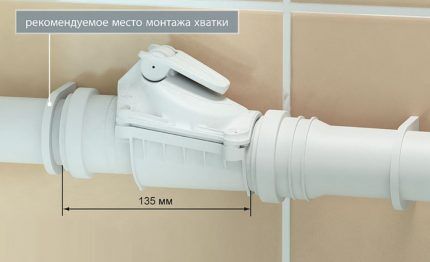
If you decide to do everything on your own, then you need to first look at the installation theory or read a short instruction on installing a check valve on a sewer system.
Firstly, you will need to check the purchased device in action before installing it. To do this, you can use, for example, a stream of water from a tap. Having tested the functionality of the valve and made sure that it only allows water to flow in one direction, you can proceed to the next stage.
The second step is to measure the length of the return device and mark its installation location taking into account these dimensions. It is important here that there is free access to the valve - periodic inspection will be necessary.
When everything is marked, you have to remove/cut off a section of the pipe, in whose place a shut-off device will be installed. During installation, you need to use an O-ring and sealant or fum tape to ensure a reliable connection and prevent leakage.
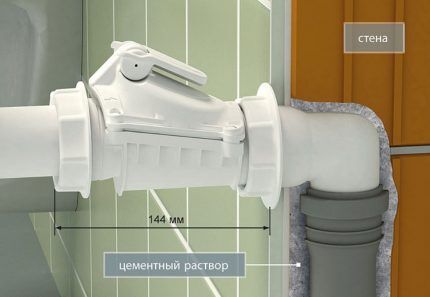
The same should be done with the remaining shut-off valves if you plan to install separate shut-off devices on each plumbing fixture.
You should correctly position the valve using the instructions included with the device, or you can look at the red arrow indicating the direction of movement of the sewer.
When all the joints of the sewer pipe with the shut-off valve are securely insulated, you should check the work done in action by opening the tap or draining the water in the drain tank.If nothing leaks at the installation site, it means everything was done efficiently and you don’t have to worry.
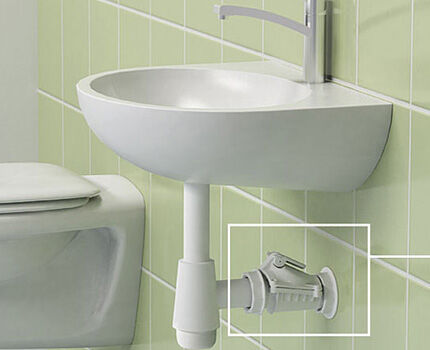
When installing a shut-off valve in a common sewer pipe in a country house/cottage, you should also ensure free access to it, even if it is located on the street. The outer part of the sewerage system, together with the device and other fittings, should be equipped with heating cable or thermal insulation system.
Rules for using the device
In order for the non-return valve to protect the house/apartment from the reverse flow of sewer water for a long time, it must be serviced in a timely manner. Therefore, it is important to provide convenient access to it.
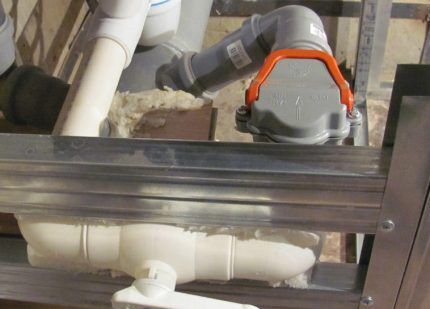
It is possible that during the process of removing used water, noise, creaking and other unpleasant sounds occur. In this case, it is necessary to check the shut-off valve ahead of time - breakdowns in the form of worn parts or unexpected clogging are possible.
If you do not check everything in time, then when the sewage flows back, the device will not be able to fulfill its purpose and dirty water will begin to come out of all plumbing fixtures.
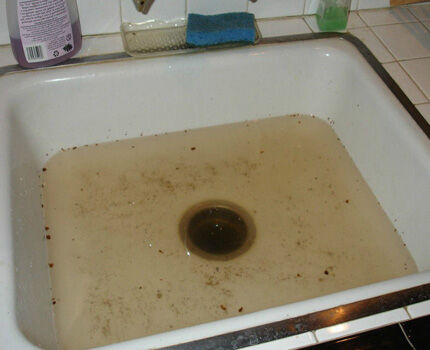
In the case when an automatic device with an electric motor is used, you must strictly adhere to the recommendations for its maintenance and change spare parts in a timely manner.The wear periods of individual elements of the device are indicated by the manufacturer in the instructions.

It happens that during the audit, wear of certain parts was discovered, which cannot be replaced - the manufacturer does not produce the necessary spare parts.
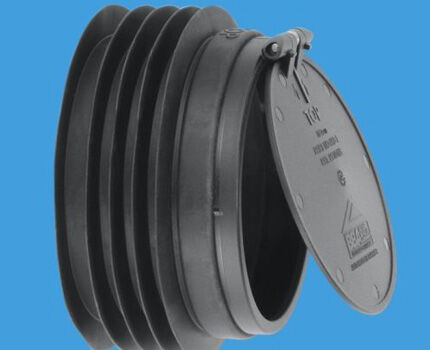
You should not repair a damaged part with improvised materials - there is no guarantee that, if necessary, a homemade damper will cope with the pressure of wastewater from the pipeline in the opposite direction.
Conclusions and useful video on the topic
Video about the benefits of a check valve and the features of its installation:
Operation of a check valve in the external part of an autonomous sewer system:
The video clearly demonstrates the operation of check valves for household networks:
Some craftsmen manage to make some kind of check valve using improvised means. More details in this video:
Installation of a shut-off valve should be carried out at the stage of assembling the sewer system. This is clearly demonstrated in the video:
You should choose a suitable check valve for the sewer system of your house/apartment taking into account the location and branch of the pipes. You can install it yourself or hire a plumber - it all depends on your skills and the amount of work to be done.
The main thing is not to forget to inspect the valve every 6-12 months and remove any blockages that appear so that it can effectively protect the house/apartment in the event of reverse flow of drains.
Would you like to talk about how you chose a check valve for your sewerage equipment? Have questions or valuable advice you would like to share with site visitors? Please write comments and leave photos on the topic in the block located under the text of the article.




The check valve has been allowing me to live in peace for four years now. Yes, I live on the first floor of a nine-story building, still built in the Soviet Union. Previously, the drains clogged at least four times a year. And they threw everything into the toilet - children's tights, bags, bones, not to mention feminine hygiene items. And then I installed a cast-iron valve in my toilet, vertical and that’s it... As a matter of fact, now the upstairs neighbors periodically have a house full of troubles. It’s a simple thing, it’s not difficult to install (it’s better to call an experienced person), but it’s very practical, it allows you to live like a white man, and not have to clean up sewage all over the riser.
Periodically, the sewage system in the apartment in Khrushchev gets clogged. The problem is that I have a daily work schedule and I am not at home for a long time. Will a non-return valve help keep your apartment safe? And won't this harm the neighbors?
Hello. First of all, I advise you to solve the problem with sewer blockages by contacting the management company. Ensuring the normal operation of the sewer system is their responsibility!
Regarding the issue of installing a check valve for the sewer, the presence of this device will protect your apartment from flooding with return water from the sewer pipe.It is better to entrust the installation to a qualified specialist; it is even better to ask for help in choosing the most suitable model specifically for your apartment. You don’t have to worry about your neighbors; installing a check valve will not affect them in any way; the neighbors above will even thank you.
I forgot to clarify - what floor do you live on? If on the first or second floor, then installing a check valve is quite justified. The third floor and above is already in question, since the column of waste liquid rarely rises above this level.
We live on the 6th floor of a 9th floor. at home This week, for the second time in five years, there was backwater flooding into the kitchen sink. Calling the emergency crew and again cleaning the riser with a 10-meter cable and flooding the floor with black slurry from the riser. On the 5th floor the water was leaking from the sink. What do you advise?
Hello. We advise you to file an official complaint with the Criminal Code, let them figure out what the reason is and solve the problem. If they don’t want to go to Rospotrebnadzor, the housing inspectorate, and so on.
I live on the 6th floor and have been flooded twice. So the words about 1-2 floors are unjustified
The 7th floor of the 12 building was also flooded, periodically there were air bubbles with splashes from the toilet and sink, no matter how much I called and complained it didn’t help, they would come and clean it and everything would repeat.
This is a question, let’s say I install this valve and when the backdraft starts, which of course I won’t know about, and at that moment I, for example, will flush the toilet. What will happen? Won't he trample everything towards me? Will the valve work? Will the water go down at all?